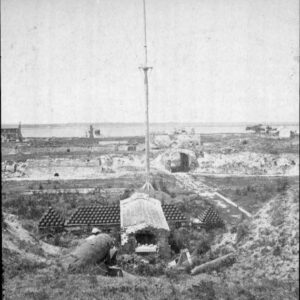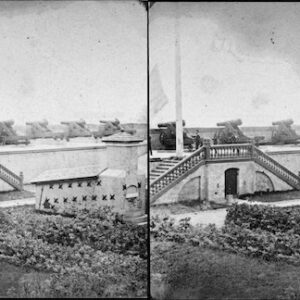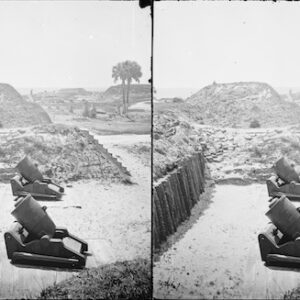Tag: Fort Moultrie SC
Wikipedia says: Fort Moultrie is a series of fortifications on Sullivan’s Island, South Carolina, built to protect the city of Charleston, South Carolina. The first fort, formerly named Fort Sullivan, built of palmetto logs, inspired the flag and nickname of South Carolina, as “The Palmetto State”. The fort was renamed for the U.S. patriot commander in the Battle of Sullivan’s Island, General William Moultrie. During British occupation, in 1780–1782, the fort was known as Fort Arbuthnot.
American Revolution
Col. Moultrie took command of Sullivan’s Island on March 2, 1776, which included a garrison of 413 men of the 2nd South Carolina Regiment of Infantry and 22 men of the 4th South Carolina Regiment, artillery. The island included a fort, still under construction at the southern tip, which was being supervised by Capt. De Brahm. The square design, with corner bastions, was supposed to have parallel rows of palmetto logs 10 feet high (3.0 m), filled in with 16 feet of sand (4.9 m). However, by June 28, only the front (the southeast and southeast curtain walls and bastions) was complete. The northern portion of the fort was unfinished, standing at only 7 ft (2.1 m). Cavaliers were constructed along the rear walls. The blue flag on the southeast bastion had the word “Liberty” on it. A total of 31 guns commanded the approach from Five Fathom Hole offshore, past the island and the Middle Ground shoal, before ships could enter the harbor.
South Carolina patriots began to build a fort to guard Charleston, South Carolina, harbor in 1776. British Admiral Sir Peter Parker with nine British warships attacked the fort—known as Fort Sullivan and incomplete—on June 28, 1776, near the beginning of the American Revolutionary War. The soft palmetto logs did not crack under bombardment but rather absorbed the shot; cannonballs reportedly even bounced off the walls of the structure. William Moultrie, commander of the 2nd South Carolina Regiment, and his four hundred men fought a day-long battle that ended with the heavily damaged British ships being driven from the area. The fort hence took its name, as Fort Moultrie, in his honor. Charleston locals celebrate “Carolina Day” to commemorate the bravery of the defenders of the fort.
During this battle, Moultrie flew a flag of his own design, authorized by the colonial government. It was later called the Moultrie flag, or Liberty flag, and became iconic to the Revolution in the South.
The British eventually captured Fort Moultrie, as part of the Siege of Charleston in spring 1780, and renamed it as Fort Arbuthnot. Nevertheless, the colonists won the war, and British troops departed in 1782, at which time the flag was presented in Charleston, by General Nathanael Greene, commander of the southern Regulars.
Early federal period
Great Britain and France began another war in 1793, heightening tensions. The United States of America thence embarked on a significant fortification program for important harbors, later called the First System of fortifications. Atop the decayed original Fort Moultrie, the Army completed a new fort in 1798; the Army also built nineteen other new forts along the Atlantic coast. The fort was garrisoned by Captain Jonathan Robeson’s company of the Regiment of Artillerists in 1802. However, after years of neglect, the Antigua–Charleston hurricane destroyed Fort Moultrie in 1804.
Fort Moultrie was rebuilt as part of the Second System of fortifications in 1808–09, under the direction of Army engineer Alexander Macomb. A report by the Secretary of War, on fortifications in December 1811, describes Fort Moultrie as:
“an irregular form, built of brick, presenting a battery of three sides on the sea front, and the whole is enclosed with ramparts, parapets, &c. mounting 40 guns. … The barracks are of brick … for five hundred (soldiers)”.
Fort Moultrie’s main design did not change much over the next five decades. The Army altered the parapet and modernized the armament, but defense of Charleston centered increasingly around newly created Fort Sumter. By the time of the American Civil War, Fort Moultrie, Fort Sumter, Fort Johnson, and Castle Pinckney surrounded and defended Charleston.
Fort Moultrie began to record meteorological observations in the early 1820s.
For fifty years the Army detained Native American prisoners at Fort Moultrie. Seminole Indian fighter Osceola and some fellow Seminoles were captured in late 1837 and transferred to the fort. Osceola died of malaria in January 1838; the Army buried his corpse at the front gate of Fort Moultrie and thereafter maintained his grave.
Civil War
In the months leading up to the Civil War, John L. Gardner was in command at Fort Moultrie. With secession growing more imminent, Gardner had made several requests to Secretary of War John B. Floyd for more troops to garrison and defend the undermanned fortress. Each time his requests were ignored, as Floyd (who joined the Confederacy) was planning to hand the forts in Charleston Harbor over to the secessionists.
South Carolina seceded from the Union on December 20, 1860, after the first election of President Abraham Lincoln. Around this time a Federal garrison from the 1st US Artillery was sent to Fort Moultrie. Unlike the state militia at the other forts, the U.S. Regular Army defenders of Fort Moultrie chose not to surrender to the South Carolina forces. On December 26, 1860, Union Major Robert Anderson moved his garrison from Fort Moultrie to the stronger Fort Sumter. On February 8, 1861, South Carolina joined the five other seceded Deep Southern states to form the Confederate States of America. In April 1861, Confederate troops shelled Fort Sumter into submission, and the American Civil War began.
In April 1863, Federal ironclads and shore batteries began a bombardment of Fort Moultrie and the other forts around Charleston harbor. Over the ensuing twenty months, Union bombardment reduced Fort Sumter to a rubble pile and pounded Fort Moultrie below a sand hill, which protected it against further bombardment. The Rifled cannon proved its superiority to brickwork fortifications but not to the endurance of the Confederate artillerymen who continued to man Fort Moultrie. In February 1865, as General Sherman marched through South Carolina, the Confederate soldiers finally abandoned the rubble of Fort Moultrie and evacuated the city of Charleston.
Showing 1–16 of 35 resultsSorted by latest
-

Image ID: AYQE
$0.99 -

Image ID: AYQF
-

Image ID: ASES
$5.99 -

Image ID: ASFX
$5.99 -

Image ID: ASHB
$5.99 -

Image ID: ASET
$5.99 -

Image ID: ASEU
$5.99 -

Image ID: ASFW
$5.99 -

Image ID: ASGX
$5.99 -

Image ID: ASGY
$5.99 -

Image ID: ASGZ
$5.99 -

Image ID: ASHA
$5.99 -

Image ID: ASAB
$5.99 -

Image ID: AHNH
$3.99 – $4.99 This product has multiple variants. The options may be chosen on the product page -

Image ID: AMUK
$5.99 -

Image ID: ALNM
$6.99